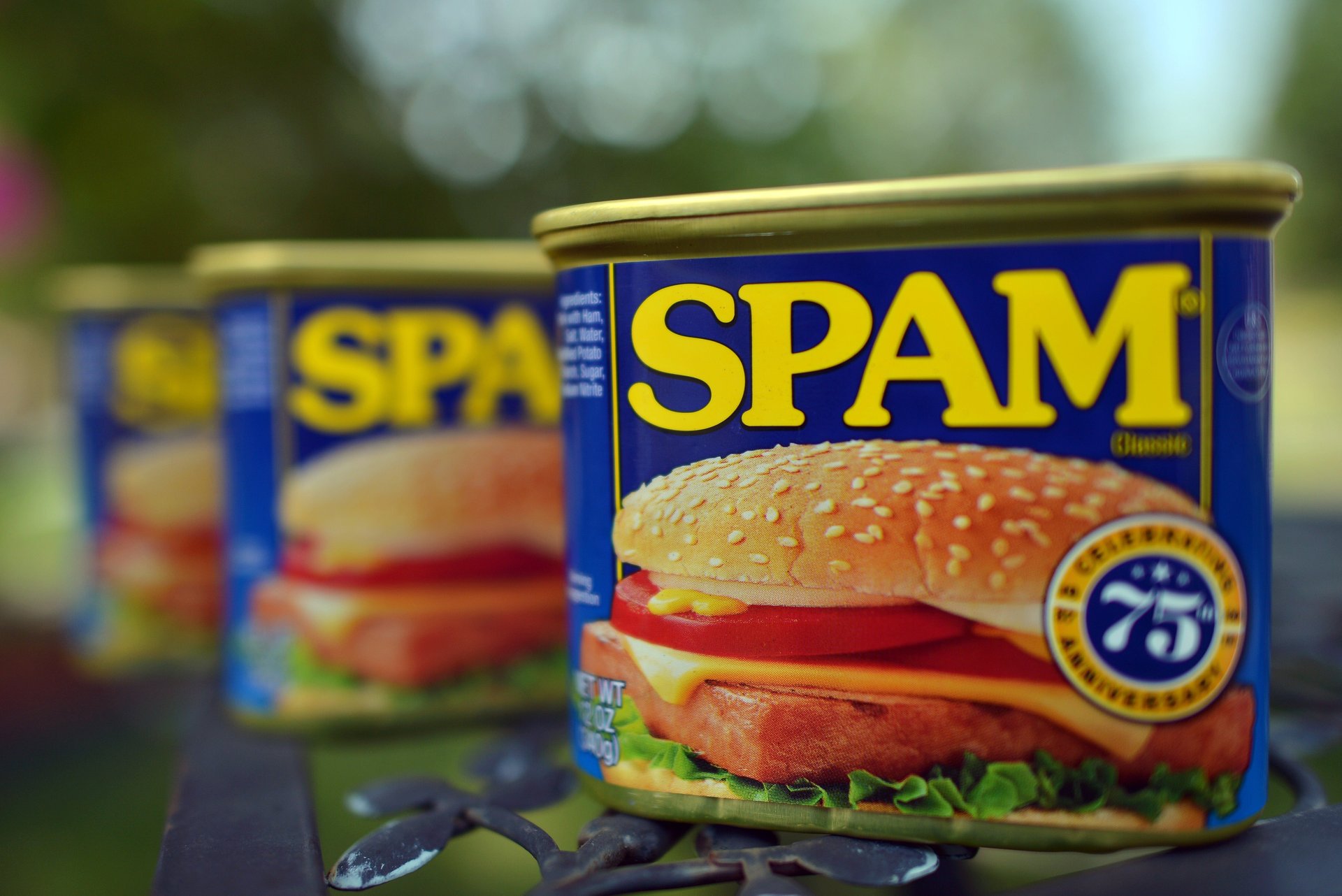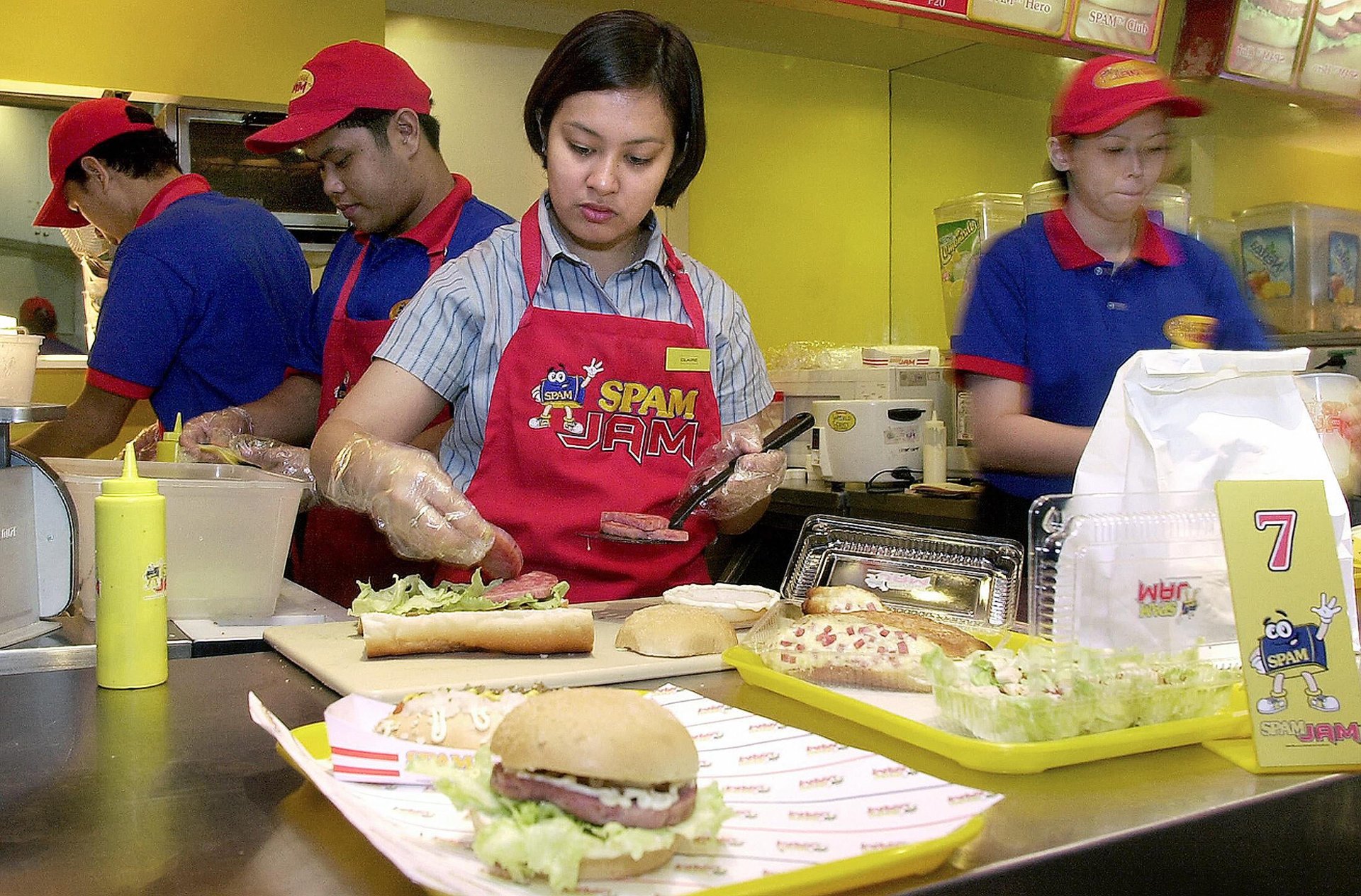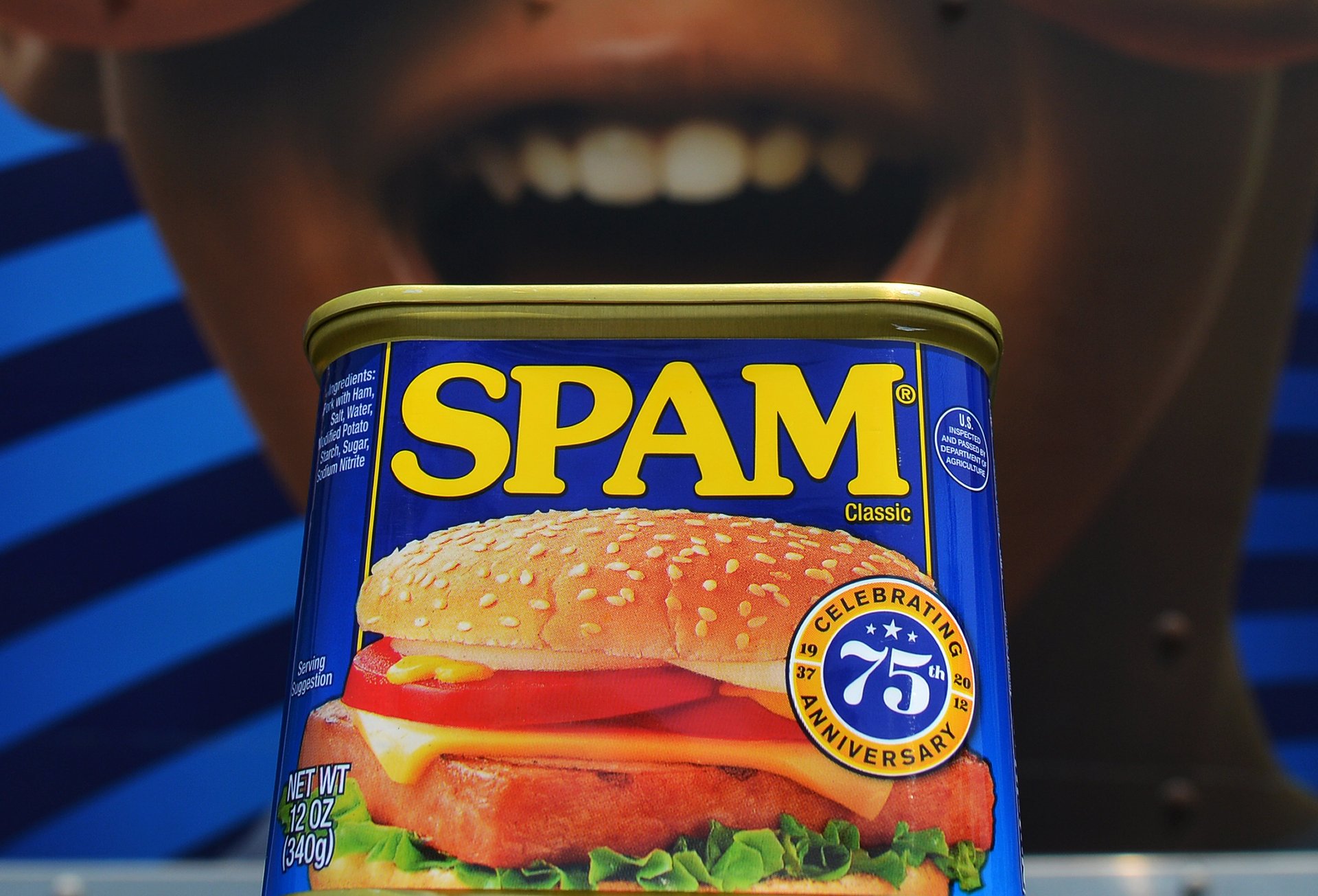Spam: America in a can
A safe investment

A safe investment
Suggested Reading
Canned cooked pork—there’s not much to it. And yet, Spam has made its way across the globe and into dishes from Puerto Rico’s sandwich de mezcla to the UK’s Spam fritters to Hawaii’s Spam musubi. With this kind of global ubiquity, it’s no surprise that Spam has beat its own sales record for the past seven years in a row.
Related Content
Hormel Foods, a US food processing company based in Austin, Minnesota, has been churning out the blue and yellow tins since 1937. The food got its name, allegedly, after the brother of a Hormel executive came up with the portmanteau for “spiced ham” for a naming contest, winning him $100. But it wasn’t until World War II that people around the globe began to associate that name with the US of A.
Spam is having a resurgence as shoppers turn to cheap and convenient food during soaring inflation. But in some places, it never stopped being cool. In South Korea, for instance, Spam is offered as a holiday gift. Part of the luncheon meat’s enduring allure is that it’s more than just something you eat—it’s rooted in tradition, versatility, convenience, and culture.
Let’s peel back the lid and see what’s inside.
By the digits
7.1%: Price increase for a 12 oz can of Spam from 2021 to 2022
10%: The jump in Spam sales amid the 2008 global financial crisis, compared to the previous year
50%: Amount Spam sales soared in 2020 compared to 2019 in South Korea, the brand’s second biggest consumer
9 billion: Approximate number of Spam cans sold to date
35,000: Attendants at the annual Waikiki Spam Jam, an event in Hawaii featuring Spam dishes

An A+ in Marketing 101
Hormel’s branding of Spam is ingenious. For one, the company magnified how versatile its product can be. Its site lists 100 recipes involving canned ham, from Spam taco kabobs to Spam risotto.
But the manufacturer also marketed the ham to be personal, positioning it to reflect American patriotism. After World War II, the Hormel Girls, a musical group of female WWII veterans, traveled the country performing songs and promoting Spam. Since then, events and museums revolving around Spam have been popularized by enthusiasts, including the Spam Museum in its hometown of Austin, Minnesota; the Spamarama cooking festival; a Spam-sponsored NASCAR race car; and even the Broadway musical Spamalot.
Perhaps that’s why the loyalty runs as thick as gelatin, and Hormel continues to innovate the 85-year-old product. CEO Jim Snee said the company is working on expanding the range of Spam products this year.
Quotable
“Spam became iconic in Asia because it was a taste of America without being in America. It’s like drinking Coke. While you can’t afford to travel to America, you can eat and drink America or enjoy a little piece of America in your life.”
—Ayalla Ruvio, consumer behavior researcher and professor in the department of marketing at Michigan State University, speaking to South China Morning Post

Pop quiz
What Spam flavor does Hormel not sell?
A. Spam with Portuguese sausage seasoning
B. Spam with tocino seasoning
C. Spam with jalapeño
D. Spam with tajín
Find the answer at the bottom.
Brief history
1795: The French government offers an award of 12,000 francs to anyone who could come up with a better method of preserving food. Parisian chef and confectioner Nicolas Appert raises his hand.
1810: During the Napoleonic Wars, Appert invents a canning method that involves designing wide-mouth bottles with corks. He presents his findings to the French government in a book called The Book of All Households or the Art of Preserving Animal and Vegetable Substances for Many Years. He wins the prize money.
1810: In the same year, based on Appert’s findings, Frenchman Philippe de Girard reportedly patents the tin can process through Englishman Peter Durand, which involves heating food and sterilizing it within a sealed tin container.
1813: Factories start producing tinned cans and find a market among seafarers.
1825: Tin plate is patented in the US. Canned oysters, fruits, meats, and vegetables are sold in New York.
1861: Louis Pasteur publishes his work on germ theory.
1880s: The UK imports 16 million pounds of canned meat, as railways, roads, and canals make it easier to move products around.
1896: “Double seaming,” a technological development that leads to a faster and more efficient canning process, is invented. Brands like Heinz capitalize on it.
Post-WWI: Food production dramatically increases in part to meet the widespread adoption of canned food.
1933-34: US president Franklin D. Roosevelt’s New Deal program delivers 692 million pounds of food—much of it being canned beef—to people in need in 30 states.
1937: Hormel Foods starts selling Spam.
1941: With the passing of the Lend-Lease Act, Hormel ships up to 15 million cans of meat per week outside the US, most of it Spam.
2007: Spam is sold in 41 countries on six continents and is trademarked in over 100 countries.
Fun fact!
What is up with the jelly layer that surrounds Spam? Natural gelatin creates the stuff inside the cans during cooking, which helps with the preservation of the meat. In 2009, potato starch was added to reduce the gooeyness. In other words, it used to be even grosser.

Watch this
In this 1970 Monty Python sketch, two customers try to order breakfast from a very annoying menu that goes a little something like this: “Egg and Spam; egg bacon and Spam; egg, bacon, sausage, and Spam; Spam; bacon sausage and Spam; Spam; egg; Spam; Spam, bacon, and Spam…”
The repetitive, excessive Spam-filled menu led to the name being adopted for unsolicited emails known as Spam mail.
Is ambition a scam?
In the 2010s, we were hustling, rising and grinding, and #girlbossing. Today, the same cans of Spam from those years might still be in the back of our cupboards, but we’re probably too burned out after work to clean them out. What’s changed?
🎧 Listen to the next episode of Work Reconsidered, on the topic of ambition, out Nov. 3.
Find it on: Apple Podcasts | Spotify | Google | Stitcher

Let’s get to the 🥩 of it!
Spam’s global success had martial origins. During WWII, it was the go-to food during rationing, making its mark in England and the Pacific Islands. It was also part of US soldiers’ diets. After the bombing of Pearl Harbor, American troops were deployed to the Pacific, landing in places like Guam, Japan, the Philippines, and South Korea. Wherever soldiers went, Spam followed, Robert Ku, a professor of Asian American studies at the State University of New York at Binghamton, told Time Magazine.
But the canned pork exchange was marked by tension, particularly for the Asia Pacific. During WWII, the US restricted deep-sea fishing industries in Hawaii, which Japanese Americans mainly ran. So, the Islanders had to replace the protein they would have got from fishing with Spam. During the Korean War in 1950, people rummaged through items from American military camps to make budae jjigae, or “army stew,” which consisted of kimchi, rice cakes, Spam, and American cheese.
When WWII ended, Americans shifted Spam away from the main entree to a side dish. But Spam stuck around where US soldiers had left, reflecting a lasting US influence on these countries. Since then, locals have found ways to adapt the canned meat to their taste.
In Asian cultures, Spam continues to be part of everyday eating. Though there’s a stigma of Spam being a poor man’s meal, it has also been embraced by many and has even played a role in cultivating the Asian American identity.

Poll
How many cans of Spam do you buy each year?
- I eat it daily
- I crack one open every so often
- Wouldn’t touch the stuff
💬 Let’s talk!
In last week’s poll about SPACs, 54% of you said you’re going to stay clear of the investments, while 33% said you’re watching to see how the latest de-SPACs are performing. Just 13% of you said that you’re intrigued!
Today’s email was written by Michelle Cheng (who aims to unsubscribe from most spam emails), and edited and produced by Morgan Haefner (can’t get over the jelly).
The correct answer to the pop quiz is D., Spam with tajín. It’s not one of the 15 flavors of Spam, but we’re petitioning for it.